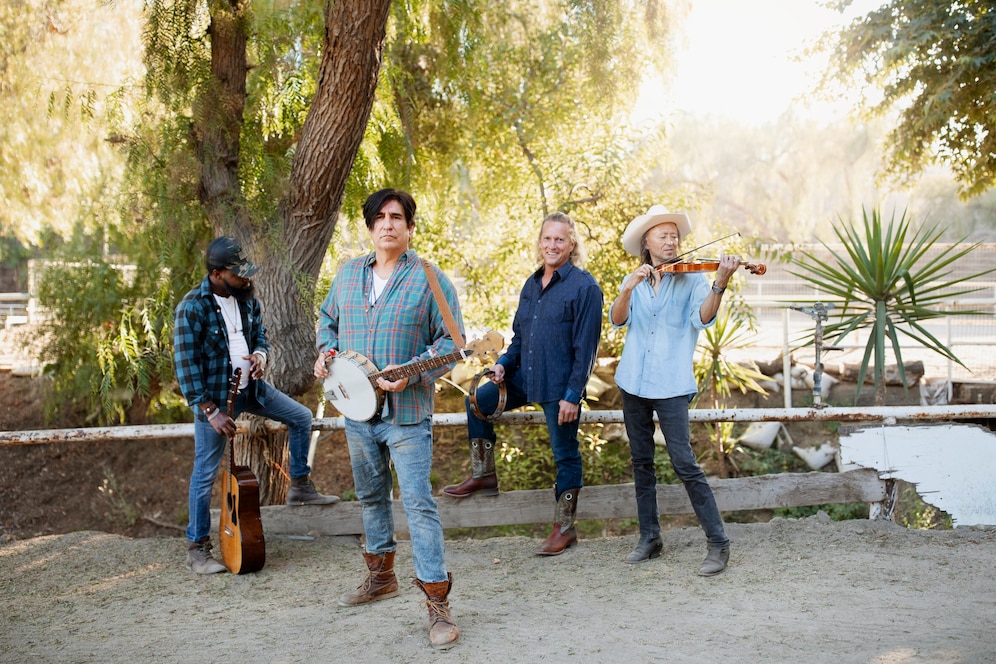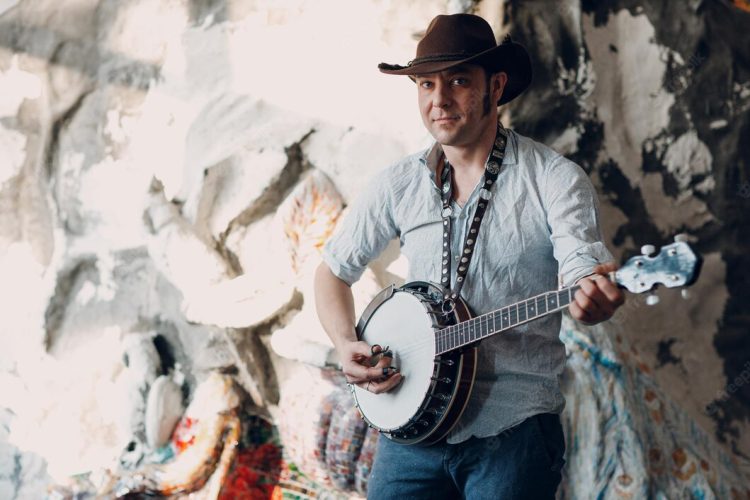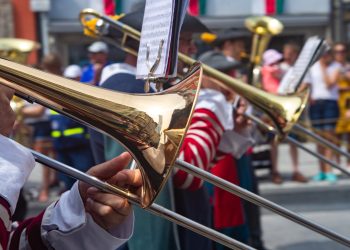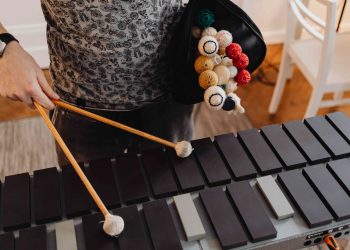Banjos are a popular and versatile stringed instrument with a distinct sound that has been used in many genres of music for hundreds of years. Despite their age, banjos remain just as popular today as ever, with many options available for players of all skill levels and budgets. With so many great brands and models to choose from, finding the ideal banjo can be a daunting task. To make it easier, this article will take a look at ten of the best banjos to help guide you through your search. From entry-level instruments to higher-priced models, everything you need to know about the top 10 best banjos will be covered.
- Ashthorpe 5-String Banjo Full Size with 24 Brackets – $153.99 – 9.4/10 – The Ashthorpe 5-String Banjo is a traditional style instrument that is perfect for any style of play. It features a guitar-style headstock and neck combined with a tambourine shaped body. The banjo is designed with a Remo head that delivers bright sound and clarity, secured with 24 chrome-plated brackets. The banjo is crafted with a mahogany neck, purpleheart fretboard, and a high-gloss finished mahogany body. It also has a geared 5th string tuner, adjustable truss rod and a closed-back resonator that can be easily removed. The bundle kit includes a padded gig bag, extra strings, polishing cloth, and celluloid picks.
- Jameson Guitars 5-String Banjo – $156.99 – 9.2/10 – The Jameson Guitars 5-String Banjo is a high-quality instrument crafted from the finest woods. It features a 5-ply maple and mahogany shell, mahogany neck, closed back mahogany resonator and a purpleheart fretboard. The banjo also has a Remo Weatherking drum head, a 5/8-inch maple ebony bridge, a chrome plated armrest, an adjustable tailpiece, and truss rod. It also has a geared 5th tuner side peg which is an upgrade over the more typical friction tuners, allowing for better control of the instrument’s sound. The banjo is designed with a removable resonator allowing the player to play it both open and closed back. This banjo bundle kit includes a deluxe 15mm padded gig bag for secure carrying and storage.
- Pyle 5 String Resonator Banjo Size 24 Bracket – $189.99 – 9.2/10 – The Pyle 5 String Resonator Banjo is a complete set that includes everything you need to start playing. The set comes with a gig bag, digital tuner, spare strings, 3 finger picks, cleaning cloth, detachable shoulder strap, hanger, and a wrench to adjust the brackets. The banjo is 38.6 inches in size and features 24 brackets and 22 frets with a classic traditional style binding design. It is handcrafted from sapele hardwood and features a coated and polished rich wood finish with chrome-plated hardware/accents. The banjo is equipped with a geared 5th string tuner, high-quality remo drum head, adjustable truss rod, pearl color tuner pegs, and an additional 5th geared tuner side-peg. The banjo also features a rich and polished Sapele wood resonator, high-density man-made wood fingerboard, and a remo milky skin banjo top.
- Mulucky 5 String Banjo Full Size with 24 Brackets – $159.99 – 9/10 – The Mulucky 5 String Banjo is a full-size instrument that is designed with a Remo head, made by the world-renowned Remo drum company. The head is secured with 24 chrome-plated brackets and resting on the Remo head is a beautiful 5/8″ maple/ebony bridge for superior string vibration transfer. The open back of the banjo produces a more mellow, softer sound and the adjustable bracket allows for even head panel tension. This 5-string banjo also includes a geared 5th string tuner, typically found on more expensive banjos and an adjustable truss rod. This banjo kit comes with a full-size banjo, spare strings set, tuner, tuning wrench, fingerpick, strap, cleaning cloth, gig bag, and ruler. If you have any questions about this banjo, the manufacturer can be contacted.
- Vangoa 5 String Banjo Remo – $209.99 – 9/10 – The Vangoa 5 String Banjo is a high-quality instrument designed with a Remo drum head that can produce a sweet tone. It is equipped with a truss rod that can adjust the string height for comfortable playing. The banjo is made with durable materials such as a mahogany neck, sides, and back with a glossy and smooth finish for a comfortable playing experience. This banjo can also be converted into an open back banjo by detaching the back, which produces a very bright sound. The banjo kit comes with a bag, guitar Tuner, Strap, Pick up, Strings, Picks, and a beginner manual, making it perfect for beginner adults. The banjo also has 24 chrome-plated brackets for stable tuning and a 14:1 gear ratio for smooth and reliable tuning.
- Kmise 5 String Resonator Banjo – $154.99 – 9/10 – The Kmise 5 String Resonator Banjo is a high-quality instrument designed with a lacquered removable back cover that can produce a pleasant sound. The player can beat the drumhead panel when plucking the string to come percussion with a beautiful melody. The banjo has a polished chrome installed armrest to provide comfort while playing. The okoume wood neck and sapele wood back combine to produce a beautiful and very distinct tone characteristic as well as looking great. The banjo also comes with a storage bag, banjo shoulder strap, extra strings, digital clip-on tuner, polishing cloth, allen wrench to adjust truss rod if needed, and quality metal finger picks. If you have any question about your banjo, the manufacturer can be contacted for a quick resolution.
- Mulucky Banjolele 4 String Banjo Ukulele Concert Size 23 Inch – $79.99 – 8.8/10 – The Mulucky Banjolele is a 4 string banjo ukulele that is perfect for musical travel. The 23 inch banjolele is lightweight, suitable for parties, courses, and is easy to use, making it perfect for beginners. The banjolele is equipped with a polyester drum skin that has great elasticity to respond quickly, premium Aquila strings from Italy, and a high-quality closed-gear tuner. The banjolele also has a comfortable 3mm motion at the 12th fret and an adjustable truss rod for perfect string height. The banjolele is made of premium sapele wood with a beautiful wood grain and is hard, not easy to warp or corrode. The banjolele also comes with a warranty service for full refund or replacement if you are not satisfied with the product.
- Kmise 4 Banjo Concert Size 23 Inch – $89.99 – 8.8/10 – The Kmise Banjolele is a 4-string concert size instrument measuring 23 inches. It’s equipped with a polyester drum head that has great elasticity and responds quickly, paired with superior Aquila strings from Italy and high-quality closed geared tuners that produce a bright and percussive tone while staying in tune well. It features a comfortable 3mm action at the 12th fret and an adjustable truss rod for perfect string height, a smooth fretboard, and neat fret wires for a comfortable touch. The package also includes a multifunctional strap that can be adjusted to any length, a Piezo pickup for stage performance, and a back cover that can be removed for either traditional resonator or open back style. The package also comes with a tuner, strap, extra strings, and a pickup. Kmise offers responsible customer service and is committed to providing the best shopping experience.
- ADM 5 String Full Size Banjo – $199.99 – 8.8/10 – The ADM 5 String Full Size Banjo is an excellent choice for both experienced and novice musicians alike. This banjo features a high-quality Remo drum head that produces a sweet and clear tone, as well as a sturdy black walnut fingerboard and bridge that ensures stability and a layered sound. The instrument is made of strong sapele sides and back with beautiful wood grain, making it resistant to warp and corrosion for increased longevity. Additionally, the banjo comes with a geared 5th tuner for classic tones and perfect for various music genres, along with a thickened bag for protection when travelling. A great value for money product, it comes with access to one month lessons and other accessories like a digital tuner, strap, strings, picks, hanger and cleaning cloth.
- Mulucky 5 String Banjo Mini – 28 Inch Travel Banjo – $119.99 – 8/10 – The Mulucky 5 String Banjo Mini is a 28 inch travel banjo that is perfect for musicians on the go. It is designed to produce a bright and percussive sound and is easy to learn, making it ideal for beginners. The banjo is constructed with a polyester drumhead and 12 brackets that ensure even head panel tension for a melodious sound. The geared 5th tuner and chrome-plated closed tuning pegs make it easy to tune and hold. The banjo comes with a complete beginner kit that includes a pick-up, strap, ruler, wrench, cleaning cloth, picks, finger picks, and spare strings. Mulucky provides a warranty service for any dissatisfaction with the banjo.

Frequently Asked Questions
[faq-schema id=”127307″]
Banjo Selection Tips

Choosing a banjo for your playing style and level can be a bit overwhelming, as there are many different options available. Here are a few factors to consider when choosing a banjo:
Type of Banjo: Consider the different types of banjos available and decide which one is best suited for your playing style. For example, if you’re interested in bluegrass or country music, a 5-string banjo would be a good choice. If you’re interested in jazz, a 4-string tenor banjo would be a better fit.
Skill level: Consider your skill level as a player when choosing a banjo. If you’re a beginner, it’s best to start with a lower-priced, entry-level model. As you improve, you can upgrade to a higher-priced, professional-grade instrument.
Size and weight: Consider the size and weight of the banjo when choosing one. A smaller, lighter banjo may be more comfortable for some players, while others may prefer a larger, heavier instrument.
Sound: The sound of the banjo is an important factor to consider. Try playing different banjos to get a sense of the different sounds and decide which one you like best.
Brand: Consider the reputation of the brand when choosing a banjo. Some brands are known for producing high-quality instruments, while others are known for producing budget-friendly options.
Budget: Consider your budget when choosing a banjo. There are options available at different price points, so it’s important to have a budget in mind and stick to it.
By considering these factors, you can find a banjo that is well-suited to your playing style, skill level, and budget. It’s also important to remember that the best way to choose a banjo is to play it, so try to find a music store near you or borrow a banjo from a friend or a music school to get a sense of how it feels and sounds.
Types of Banjos
There are several different types of banjos, each with their own unique characteristics and uses.
The four-string tenor banjo is smaller in size and is typically used in Dixieland jazz and Irish traditional music.
The five-string bluegrass banjo is the most common and popular type of banjo. It is characterized by its bright and cutting sound, and is often used in bluegrass, country, and folk music.
The six-string banjo guitar, also known as a banjitar, is a hybrid instrument that combines the banjo’s drum-like body with the six strings of a guitar. It is used to play a wide range of music genres.
The plectrum banjo is similar in design to the five-string banjo but is typically larger and has a longer neck. It is played with a plectrum and is used in jazz and ragtime music.
The open-back banjo is characterized by its open-backed drum-like body and is typically used in old-time and folk music.
The resonator banjo, also known as the bluegrass banjo, is characterized by its metal resonator on the back of the instrument, which amplifies the sound. It is typically used in bluegrass and country music.
Banjo Brands
There are many popular brands of banjos available in the market, each with their own unique characteristics and features. Here are a few notable brands:
Gibson: Gibson is a well-known brand in the music industry and has been producing banjos since the early 1900s. They are known for their high-quality craftsmanship and are considered some of the best banjos available.
Deering: Deering is a family-owned company that has been making banjos for over 40 years. They are known for producing high-quality instruments with a focus on traditional and bluegrass styles.
Martin: Martin is another well-known brand in the music industry, and their banjos are known for their excellent tone and craftsmanship. They offer a wide range of banjos, from entry-level to professional-grade instruments.
Gold Tone: Gold Tone is a company that specializes in producing affordable banjos for players of all skill levels. They are known for producing instruments that are both high-quality and budget-friendly.
Epiphone: Epiphone is a subsidiary of Gibson and produces a wide range of musical instruments, including banjos. They are known for producing budget-friendly instruments that are of good quality.
Vega: Vega is a historic brand with a long history of producing high-quality banjos, they are known for producing banjos that are versatile and suitable for different playing styles.
These are some of the most popular brands of banjos, but there are many other brands available as well, each with their own unique features and qualities. It’s always best to try different brands and models to find the one that best suits your playing style and preferences.
How to Learn to Play the Banjo (Step by Step)
Learning to play the banjo can be a fun and rewarding experience, but it can also be a bit overwhelming if you’re not sure where to start. Here are some step-by-step instructions to help you get started on your banjo-playing journey.
Choose a banjo. There are several different types of banjos, including five-string, four-string, and six-string banjos. Each type of banjo has its own unique sound and feel, so it’s important to choose one that you like and that suits your playing style.
Learn the basics. Before you start playing, it’s important to learn the basics of how to hold the banjo and how to pluck the strings. You should also learn how to tune the banjo, which can be done by ear or with the help of a tuner.
Start playing simple songs. Once you’ve learned the basics, you can start playing simple songs to help you get the hang of the instrument. You can find tabs and chords for simple songs online, or you can purchase a beginner’s banjo book or DVD.
Practice regularly. To improve your playing, it’s important to practice regularly. Try to set aside a specific time each day to practice, even if it’s just for a few minutes.
Learn different techniques. As you become more comfortable with the banjo, you can start to learn different techniques such as clawhammer and bluegrass styles. These different techniques will add variety to your playing and help you to become a more well-rounded banjo player.
Join a group or take lessons. Playing with others or taking lessons from a professional banjo player can help you to improve your skills and learn new techniques. It can also be a lot of fun and a great way to meet other banjo players.
Experiment with different types of music. The banjo is a versatile instrument that can be played in a variety of styles, from bluegrass to jazz to rock. Experiment with different types of music to find the style that you enjoy playing the most.
Never give up. Learning to play the banjo takes time and practice. Don’t get discouraged if you hit a rough patch or if you’re not progressing as quickly as you’d like. Remember that it takes time to develop the skills necessary to become a proficient banjo player.
How do I tune a banjo?
Tuning a banjo involves adjusting the tension of the strings to the correct pitch in order to play in tune. The most common tuning for a five-string banjo is called “Open G,” which is G, D, G, B, D. The four-string tenor banjo is typically tuned to C, G, D, A. The six-string banjo guitar is tuned like a standard guitar, E, A, D, G, B, E.
There are several ways to tune a banjo:
Using a Tuner: An electronic tuner is a simple and accurate way to tune your banjo. The tuner will detect the pitch of the string and display the corresponding note.
By Ear: If you are familiar with the sound of the notes, you can tune your banjo by ear. You can use a reference pitch, such as a piano or another instrument, to tune each string one at a time.
Using a tuning app: There are several tuning apps available for smartphones and tablets that can help you tune your banjo.
It is important to check and adjust the tuning of your banjo before playing and occasionally while playing, as the strings may slip out of tune due to changes in temperature or humidity, or as they stretch with use.
How do I change the strings on a banjo?
Changing the strings on a banjo is a relatively simple process that can be done at home with a few basic tools.
Here are the general steps for changing the strings on a banjo:
Gather the necessary tools: You will need a new set of strings, a pair of wire cutters, and a string winder (if you have one).
Remove the old strings: Begin by loosening the tension on the strings by turning the tuning pegs counterclockwise. Once the strings are loose, use the wire cutters to cut the strings close to the bridge.
Clean the fingerboard and frets: Use a dry cloth or a guitar polish to clean the fingerboard and frets. This will remove any dirt or grime that may have accumulated and will help prolong the life of your new strings.
Install the new strings: Begin by threading one end of the string through the hole in the tuning peg. Then wind the string around the tuning peg, making sure to keep the string tight. Repeat this process for each string.
Tune the banjo: Once all the strings are installed, use a tuner to bring the strings up to pitch.
It’s important to remember that the process of changing the strings may vary depending on the banjo you are using, so it’s always good to consult the manufacturer’s instructions or refer to a reputable guide or tutorial.
It’s also worth noting that frequent string changes are essential for maintaining the optimal sound and playability of your banjo, and it’s recommended to change strings every 2-3 months or as needed.
What are the parts of a banjo and their functions?
The parts of a banjo and their functions are as follows:
Head: The head is the top part of the banjo where the strings are stretched over. It is typically made of animal skin or synthetic material and is responsible for creating the drum-like sound of the banjo.
Rim: The rim is the circular part of the banjo that surrounds the head. It’s typically made of wood and gives the banjo its shape.
Pot: The pot is the main body of the banjo and holds the rim, head, and hardware together.
Neck: The neck is the long wooden part of the banjo that extends from the pot. It contains the fingerboard and tuning pegs.
Fingerboard: The fingerboard is the flat surface on the neck of the banjo where the strings are pressed to create different notes.
Frets: The frets are the thin metal bars that run perpendicular to the strings on the fingerboard. They divide the fingerboard into different sections, which correspond to different notes.
Tuning pegs: The tuning pegs are the mechanical devices located at the top of the neck that are used to adjust the tension of the strings and tune the banjo.
Bridge: The bridge is the small wooden piece that sits on the head of the banjo and supports the strings.
Tailpiece: The tailpiece is the small metal piece that sits at the base of the banjo and holds the strings in place.
Resonator (on resonator banjos): The resonator is a metal piece located on the back of the banjo that amplifies the sound.
Armrest (on some banjos): The armrest is a small piece of metal or wood that sits on the lower part of the pot and provides a comfortable place for the player’s arm to rest.
Each part plays an important role in the overall function and sound of the banjo and they work together to produce the unique sound that is associated with this instrument.
How do I care for my banjo to ensure it lasts a long time?
Caring for a banjo is important to ensure that it lasts a long time and maintains its optimal sound and playability. Here are a few tips for caring for a banjo:
Keep it clean: Regularly wipe down the banjo with a dry cloth to remove dust and grime. This will help to prevent damage to the finish and will also prolong the life of the strings.
Protect it from extreme temperatures and humidity: Avoid exposing the banjo to extreme temperatures or humidity, as this can cause the wood to warp or crack. Always store the banjo in a room with moderate temperature and humidity.
Keep the strings in good condition: Change the strings on a regular basis and keep them clean and lubricated. This will ensure that the banjo sounds its best and will also prolong the life of the strings.
Handle with care: Always handle the banjo with care, especially when transporting it. Use a soft case or gig bag to protect it from scratches and dings.
Regular maintenance: Take your banjo to a professional for regular maintenance and repairs as needed. This will ensure that all the parts are in good working order and will also help to identify and fix any potential issues before they become major problems.
By following these tips and being mindful of your banjo’s care and maintenance, you can ensure that your banjo lasts for many years and continues to sound great.
History of the Banjo
The banjo is a stringed musical instrument that has a long and rich history. The origins of the banjo can be traced back to West Africa, where a similar instrument known as the akonting was played by the Jola people. The akonting had a gourd body and a long neck with three or four strings, and it was played with a plectrum or the fingers.
The banjo as we know it today was first developed by enslaved Africans in the United States in the 18th century. The instrument was created by attaching a skin head to a gourd body and a wooden neck with frets. The banjo was initially used as a folk instrument by enslaved Africans and African Americans, who used it to play music for work, entertainment, and religious ceremonies.
In the 19th century, the banjo began to gain popularity among white Americans, particularly in the South. Minstrel shows, which featured white performers in blackface, popularized the banjo and helped to spread its popularity throughout the country. The minstrel banjo was typically played with a strumming technique known as frailing, which is similar to the clawhammer style that had been developed by enslaved Africans.
In the late 19th and early 20th centuries, the banjo underwent a series of innovations that transformed it into the instrument we know today. The introduction of the fifth string, which is tuned to a higher pitch than the other strings, allowed for more complex playing techniques. The development of the resonator, which amplified the sound of the banjo, made it a more prominent instrument in a band setting.
In the 1920s and 1930s, the banjo became a popular instrument in the emerging genre of jazz music. Jazz banjo players like Fred Van Eps and Harry Reser helped to popularize the instrument and pave the way for its use in other styles of music.
In the 1940s and 1950s, the banjo experienced a resurgence in popularity thanks to the rise of bluegrass music. Bluegrass banjo players like Earl Scruggs and Don Reno helped to develop a new style of banjo playing known as Scruggs-style or three-finger style, which is characterized by a fast and intricate picking technique.
In recent years, the banjo has experienced a resurgence in popularity thanks to its use in a variety of music genres such as folk, country, and indie rock. Some popular contemporary banjo players include Bela Fleck, Abigail Washburn, and Noam Pikelny.
David Mahon is research assistant and part-time writer for SingersRoom.com. David has always enjoyed music and helping others reach their full potential.









